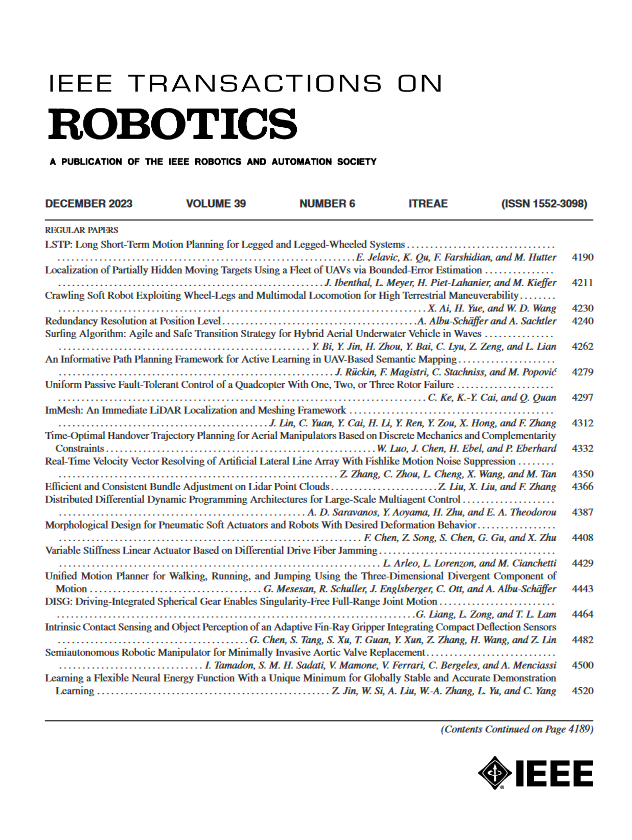Nonrepetitive-Path Iterative Learning and Control for Human-Guided Robotic Operations on Unknown Surfaces
IF 10.5
1区 计算机科学
Q1 ROBOTICS
引用次数: 0
Abstract
Automation of abrasive machining operations has become a challenging aspect in the remanufacturing industry where it is required to conduct operations on a surface of which the exact dimensions are unknown. In such cases, skilled human workers have to step in to perform labor-intensive tasks with inconsistent quality. In existing research work, collaborative robots are used to partially automate such operations under human supervision. However, these methods do not perform learning and control simultaneously and are often affected by the interactions of the human operator. In this article, a novel learning and control scheme is proposed where the robot explores an unknown surface iteratively while achieving the desired contact control performance under supervision and occasional interference from the human operator. The unknown surface is divided into subregions, and the learning and control parameters are updated each time the robot visits each subregion. This method is independent of the path of the robot and, thus, is unaffected by the irregularities introduced by a human operator’s interactions. The proposed method is applied to force control, stiffness learning, and orientation adaptation cases. The validity of this method is shown via simulations as well as experiments conducted using a Kinova Gen3 7-degrees of freedom robot.基于非重复路径迭代学习与控制的人制导机器人在未知表面上的操作
磨料加工操作的自动化已经成为再制造行业中一个具有挑战性的方面,因为它需要在精确尺寸未知的表面上进行操作。在这种情况下,熟练的人类工人不得不介入,以执行质量不稳定的劳动密集型任务。在现有的研究工作中,协作机器人被用于在人类监督下部分自动化这些操作。然而,这些方法不能同时进行学习和控制,并且经常受到人类操作员的交互影响。在本文中,提出了一种新的学习和控制方案,该方案使机器人在人类操作员的监督和偶尔干扰下,迭代地探索未知表面,同时达到期望的接触控制性能。将未知表面划分为子区域,机器人每次访问每个子区域时更新学习参数和控制参数。该方法独立于机器人的路径,因此不受人类操作员交互引入的不规则性的影响。该方法应用于力控制、刚度学习和方向自适应等实例。通过对Kinova Gen3型7自由度机器人的仿真和实验,验证了该方法的有效性。
本文章由计算机程序翻译,如有差异,请以英文原文为准。
求助全文
约1分钟内获得全文
求助全文
来源期刊

IEEE Transactions on Robotics
工程技术-机器人学
CiteScore
14.90
自引率
5.10%
发文量
259
审稿时长
6.0 months
期刊介绍:
The IEEE Transactions on Robotics (T-RO) is dedicated to publishing fundamental papers covering all facets of robotics, drawing on interdisciplinary approaches from computer science, control systems, electrical engineering, mathematics, mechanical engineering, and beyond. From industrial applications to service and personal assistants, surgical operations to space, underwater, and remote exploration, robots and intelligent machines play pivotal roles across various domains, including entertainment, safety, search and rescue, military applications, agriculture, and intelligent vehicles.
Special emphasis is placed on intelligent machines and systems designed for unstructured environments, where a significant portion of the environment remains unknown and beyond direct sensing or control.
 求助内容:
求助内容: 应助结果提醒方式:
应助结果提醒方式:


